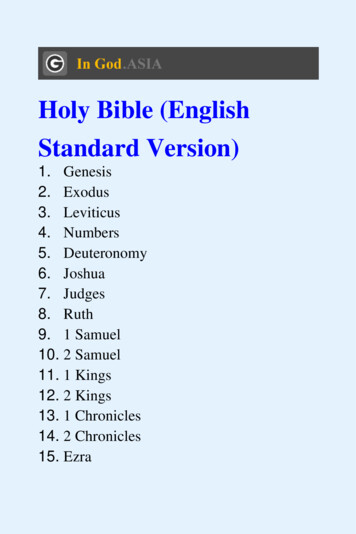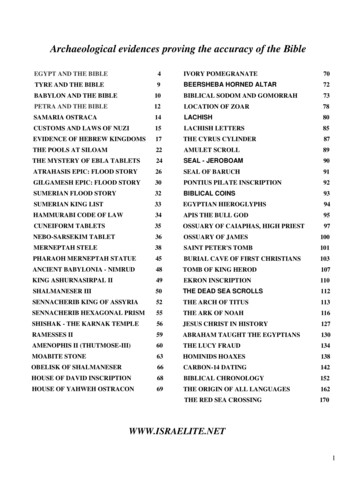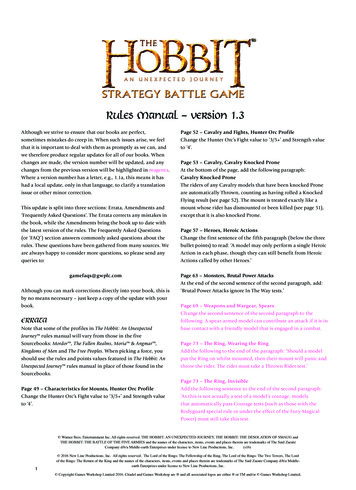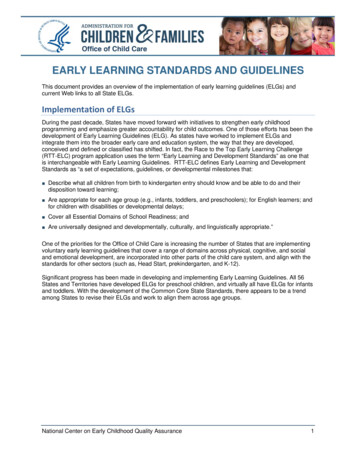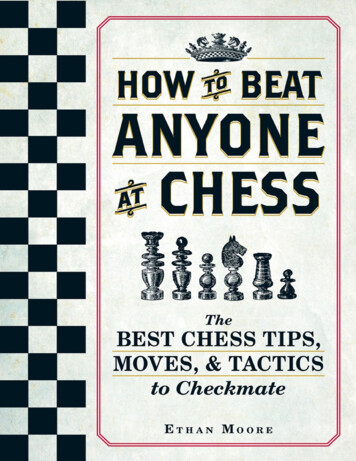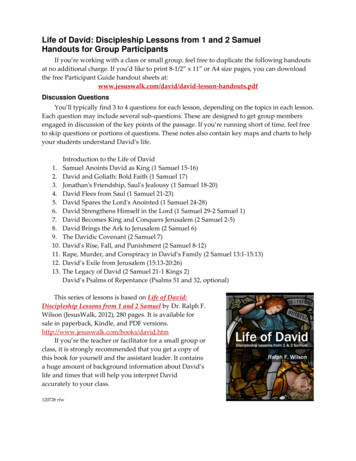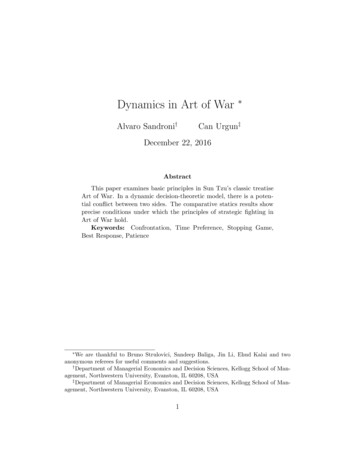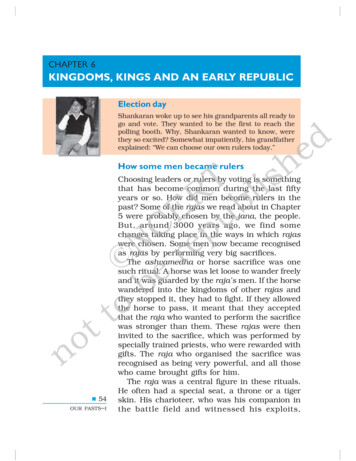
Transcription
CHAPTER 6KINGDOMS, KINGS AND AN EARLY REPUBLICElection dayShankaran woke up to see his grandparents all ready togo and vote. They wanted to be the first to reach thepolling booth. Why, Shankaran wanted to know, werethey so excited? Somewhat impatiently, his grandfatherexplained: “We can choose our own rulers today.”dehsTilRbEuCpeNr ebottHow some men became rulerson 54OUR PASTS–IChoosing leaders or rulers by voting is somethingthat has become common during the last fiftyyears or so. How did men become rulers in thepast? Some of the rajas we read about in Chapter5 were probably chosen by the jana, the people.But, around 3000 years ago, we find somechanges taking place in the ways in which rajaswere chosen. Some men now became recognisedas rajas by performing very big sacrifices.The ashvamedha or horse sacrifice was onesuch ritual. A horse was let loose to wander freelyand it was guarded by the raja’s men. If the horsewandered into the kingdoms of other rajas andthey stopped it, they had to fight. If they allowedthe horse to pass, it meant that they acceptedthat the raja who wanted to perform the sacrificewas stronger than them. These rajas were theninvited to the sacrifice, which was performed byspecially trained priests, who were rewarded withgifts. The raja who organised the sacrifice wasrecognised as being very powerful, and all thosewho came brought gifts for him.The raja was a central figure in these rituals.He often had a special seat, a throne or a tigerskin. His charioteer, who was his companion inthe battle field and witnessed his exploits,
chanted tales of his glory. His relatives, especiallyhis wives and sons, had to perform a variety ofminor rituals. The other rajas were simplyspectators who had to sit and watch theperformance of the sacrifice. Priests performedthe rituals including the sprinkling of sacred wateron the king. The ordinary people, the vish orvaishya, also brought gifts. However, some people,such as those who were regarded as shudras bythe priests, were excluded from many rituals.Make a list of all those who would be presentat the sacrifice. Which are the categories that aredescribed in terms of their occupation?dehsTilRbEuCpeNr ebottVarnasWe have many books that were composed in north India, especially inthe areas drained by the Ganga and the Yamuna, during this period.These books are often called later Vedic, because they were composedafter the Rigveda about which you learnt in Chapter 5. These includethe Samaveda, Yajurveda and Atharvaveda, as well as other books.These were composed by priests, and described how rituals were to beperformed. They also contained rules about society.There were several different groups in society at this time — priestsand warriors, farmers, herders, traders, crafts persons, labourers, fishingfolk, and forest people. Some priests and warriors were rich, as weresome farmers and traders. Others, including many herders, craftspersons, labourers, fishing folk and hunters and gatherers, were poor.The priests divided people into four groups, called varnas. Accordingto them, each varna had a different set of functions.The first varna was that of the brahmin. Brahmins were expected tostudy (and teach) the Vedas, perform sacrifices and receive gifts.In the second place were the rulers, also known as kshatriyas. Theywere expected to fight battles and protect people.Third were the vish or the vaishyas. They were expected to be farmers,herders, and traders. Both the kshatriyas and the vaishyas couldperform sacrifices.on55 KINGDOMS, KINGS ANDAN EARLY REPUBLIC
Last were the shudras, who had to serve the other three groups andcould not perform any rituals. Often, women were also grouped with theshudras. Both women and shudras were not allowed to study the Vedas.The priests also said that these groups were decided on the basis ofbirth. For example, if one’s father and mother were brahmins one wouldautomatically become a brahmin, and so on. Later, they classified somepeople as untouchable. These included some crafts persons, huntersand gatherers, as well as people who helped perform burials andcremations. The priests said that contact with these groups was polluting.Many people did not accept the system of varna laid down by thebrahmins. Some kings thought they were superior to the priests. Othersfelt that birth could not be a basis for deciding which varna peoplebelonged to. Besides, some people felt that there should be no differencesamongst people based on occupation. Others felt that everybody shouldbe able to perform rituals. And others condemned the practice ofuntouchability. Also, there were many areas in the subcontinent, suchas the north-east, where social and economic differences were not verysharp, and where the influence of the priests was limited.Why did people oppose the system of varnas?dehsTilRbEuCpeNr ebottPainted Grey Ware.Plates and bowls are themost common vesselsmade out of PaintedGrey Ware. These areextremely fine to touch,with a nice, smoothsurface. Perhaps thesewere used on specialoccasions, for importantpeople, and to servespecial food.on 56OUR PASTS–IJanapadasThe rajas who performed these big sacrifices werenow recognised as being rajas of janapadas ratherthan janas. The word janapada literally meansthe land where the jana set its foot, and settleddown. Some important janapadas are shown onMap 4 (page 57).Archaeologists have excavated a number ofsettlements in these janapadas, such as PuranaQila in Delhi, Hastinapur near Meerut, andAtranjikhera, near Etah (the last two are inUttar Pradesh). They found that people livedin huts, and kept cattle as well as otheranimals. They also grew a variety of crops— rice, wheat, barley, pulses, sugarcane,sesame and mustard.Is there a crop in this list that was notmentioned in Chapter 4?
They made earthen pots. Some of these weregrey in colour, others were red. One special typeof pottery found at these sites is known as PaintedGrey Ware. As is obvious from the name, thesegrey pots had painted designs, usually simplelines and geometric patterns.dehsTilRbEuCpeNr ebottMahajanapadasAbout 2500 years ago, some janapadas becamemore important than others, and were known asmahajanapadas. Some of these are shown on Map4. Most mahajanapadas had a capital city, manyof these were fortified. This means that huge wallsof wood, brick or stone were built around them.MAP : 4Important Janapadas,Mahajanapadas and Citieson57 KINGDOMS, KINGS ANDAN EARLY REPUBLIC
Forts were probably built because people wereafraid of attacks from other kings and neededprotection. It is also likely that some rulers wantedto show how rich and powerful they were bybuilding really large, tall and impressive wallsaround their cities. Also in this way, the land andthe people living inside the fortified area could becontrolled more easily by the king. Building suchhuge walls required a great deal of planning.Thousands, if not lakhs of bricks or stone had tobe prepared. This in turn meant enormous labour,provided, possibly, by thousands of men, womenand children. And resources had to be found forall of this.dehsTilRbEuCpeNr ebottThe fortification wall atKaushambi.This is a picture ofremains of a wall made ofbrick, found nearpresent-day Allahabad(Uttar Pradesh). A partof it was probably builtabout 2500 years ago.on 58OUR PASTS–I
The new rajas now began maintaining armies.Soldiers were paid regular salaries and maintainedby the king throughout the year. Some paymentswere probably made using punch marked coins(see the illustration on page 92). You will readmore about these coins in Chapter 9.List two ways in which the rajas of themahajanapadas wer e dif ferent from thosementioned in the Rigveda.dehsTilRbEuCpeNr ebottTaxesAs the rulers of the mahajanapadas were(a) building huge forts (b) maintaining big armies,they needed more resources. And they neededofficials to collect these. So, instead of dependingon occasional gifts brought by people, as in thecase of the raja of the janapadas, they startedcollecting regular taxes. Taxes on crops were the most important. This wasbecause most people were farmers. Usually, the taxwas fixed at 1/6th of what was produced. This wasknown as bhaga or a share. There were taxes on crafts persons as well. Thesecould have been in the form of labour. For example,a weaver or a smith may have had to work for a dayevery month for the king. Herders were also expected to pay taxes in the formof animals and animal produce.on There were also taxes on goods that were boughtand sold, through trade. And hunters and gatherers also had to provideforest produce to the raja.What do you think would have been providedby hunters and gatherers?59 KINGDOMS, KINGS ANDAN EARLY REPUBLIC
Changes in agricultureThere were two major changes in agriculturearound this time. One was the growing use ofiron ploughshares. This meant that heavy, clayeysoil could be turned over better than with awooden ploughshare, so that more grain couldbe produced. Second, people began transplantingpaddy. This meant that instead of scattering seedon the ground, from which plants would sprout,saplings were grown and then planted in thefields. This led to increased production, as manymore plants survived. However, it was backbreaking work. Generally, slave men and women,(dasas and dasis) and landless agriculturallabourers (kammakaras) had to do this work.Can you think why kings would encouragethese changes?dehsTilRbEuCpeNr ebottA closer look — (a) Magadhaon 60OUR PASTS–IFind Magadha on Map 4 (page 57). Magadhabecame the most important mahajanapada inabout two hundred years. Many rivers such asthe Ganga and Son flowed through Magadha. Thiswas important for (a) transport, (b) water supplies(c) making the land fertile. Parts of Magadha wereforested. Elephants, which lived in the forest,could be captured and trained for the army.Forests also provided wood for building houses,carts and chariots. Besides, there were iron oremines in the region that could be tapped to makestrong tools and weapons.Magadha had two very power ful rulers,Bimbisara and Ajatasattu, who used all possiblemeans to conquer other janapadas. MahapadmaNanda was another important ruler. He extendedhis control up to the north-west part of thesubcontinent. Rajagriha (present-day Rajgir) inBihar was the capital of Magadha for several years.
Later the capital was shifted to Pataliputra(present-day Patna).More than 2300 years ago, a ruler namedAlexander, who lived in Macedonia in Europe,wanted to become a world conqueror. Of course,he didn’t conquer the world, but did conquer partsof Egypt and West Asia, and came to the Indiansubcontinent, reaching up to the banks of theBeas. When he wanted to march furthereastwards, his soldiers refused. They were scared,as they had heard that the rulers of India hadvast ar mies of foot soldiers, chariots andelephants.In what ways were these armies different fromthose described in the Rigveda?dehsTilRbEuCpeNr ebottA closer look — (b) VajjiWhile Magadha became a powerful kingdom, Vajji,with its capital at Vaishali (Bihar), was under adifferent form of government, known as gana orsangha.In a gana or a sangha there were not one, butmany rulers. Sometimes, even when thousandsof men ruled together, each one was known as araja. These rajas performed rituals together. Theyalso met in assemblies, and decided what had tobe done and how, through discussion and debate.For example, if they were attacked by an enemy,they met to discuss what should be done to meetthe threat. However, women, dasas andkammakaras could not participate in theseassemblies.Both the Buddha and Mahavira (about whomyou will read in Chapter 7) belonged to ganas orsanghas. Some of the most vivid descriptions oflife in the sanghas can be found in Buddhistbooks.onGanaIs used for agroup that hasmany members.SanghaMeansorganisation orassociation.61 KINGDOMS, KINGS ANDAN EARLY REPUBLIC
tificationarmyThis is an account of the Vajjis from the DighaNikaya, a famous Buddhist book, which containssome of the speeches of the Buddha. These werewritten down about 2300 years ago.Ajatasattu and the VajjisAjatasattu wanted to attack the Vajjis. He sent hisminister named Vassakara to the Buddha to gethis advice on the matter.The Buddha asked whether the Vajjis metfrequently, in full assemblies. When he heard thatthey did, he replied that the Vajjis would continueto prosper as long as:dehsTilRbEuCpeNr ebotttaxtransplantationgana or sanghademocracy They held full and frequent public assemblies. They met and acted together. They followed established rules. They respected, supported and listened to elders. Vajji women were not held by force or captured. Chaityas (local shrines) were maintained in bothtowns and villages. Wise saints who followed different beliefs wererespected and allowed to enter and leave thecountry freely.In what ways was the Vajji sangha different fromthe other mahajanapadas? Try and list at leastthree differences.on 62OUR PASTS–IRajas of powerful kingdoms tried to conquerthe sanghas. Nevertheless, these lasted for a verylong time, till about 1500 years ago, when thelast of the ganas or sanghas were conquered bythe Gupta rulers, about whom you will read inChapter 11.
ElsewhereFind Greece and Athens in your atlas.Around 2500 years ago, the people of Athens set up a form ofgovernment, which was called a democracy, which lasted for about 200years.All free men over the age of 30 were recognised as full citizens.There was an assembly that met at least 40 times a year to decide onimportant matters.All citizens could attend these meetings.Appointments for many positions were made through lottery. All thosewho wanted to be chosen gave in their names, and then some wereselected through lottery.Citizens were expected to serve in the army and the navy.However, women were not considered citizens.Also, many foreigners, who lived and worked in Athens as merchantsand crafts persons did not have rights as citizens.Besides, there were several thousand slaves in Athens, who workedin mines, fields, households and workshops. They too were not treatedas citizens.Do you think this was a true democracy?dehsTilRbEuCpeNr ebottImagineYou are peeping through a crack in the walls of theassembly of Vaishali, where a meeting is in progress todiscuss ways to deal with an attack by the king ofMagadha. Describe what you might hear.Let’s recallon1.State whether true or false:(a) Rajas who let the ashvamedha horse passthrough their lands were invited to the sacrifice.(b) The charioteer sprinkled sacred water on the king.(c) Archaeologists have found palaces in thesettlements of the janapadas.(d) Pots to store grain were made out of PaintedGrey Ware.(e) Many cities in mahajanapadas were fortified.63 KINGDOMS, KINGS ANDAN EARLY REPUBLIC
SOME IMPORTANT2.DATESXFill in the chart given below with the terms: huntergatherers, farmers, traders, crafts persons, herders.New kinds of rajas(about 3000 yearsago)XMahajanapadas (about2500 years ago)XAlexander’s invasion,composition of theDigha Nikaya (about2300 years ago)XEnd of the ganas orsanghas (about 1500years ago)THOSE WHO PAID TAXESdehsTilRbEuCpeNr ebottTHE RAJA OF THEMAHAJANAPADA3.Who were the groups who could not participate in theassemblies of the ganas?Let’s discuss4.Why did the rajas of mahajanapadas build forts?5.In what ways are present-day elections different fromthe ways in which rulers were chosen in janapadas?Let’s doon 64OUR PASTS–I6.Find the state in which you live in the political mapon page 136. Were there any janapadas in your state?If yes, name them. If not, name the janapadas thatwould have been the closest to your state, and mentionwhether they were to the east, west, north or south.7.Find out whether any of the groups mentioned inanswer 2 pay taxes today.8.Find out whether the groups mentioned in answer 3have voting rights at present.
folk, and forest people. Some priests and warriors were rich, as were some farmers and traders. Others, including many herders, crafts persons, labourers, fishing folk and hunters and gatherers, were poor. The priests divided people into four groups, called varnas. Accord
